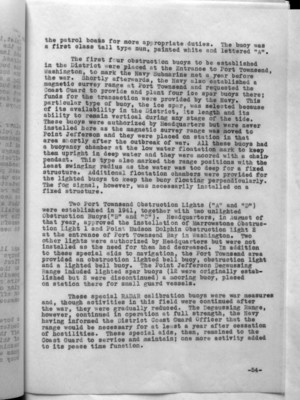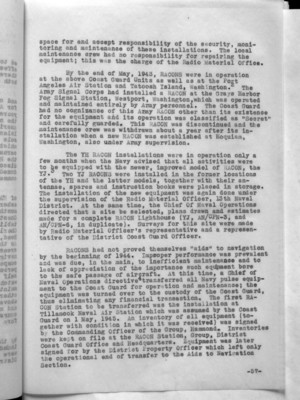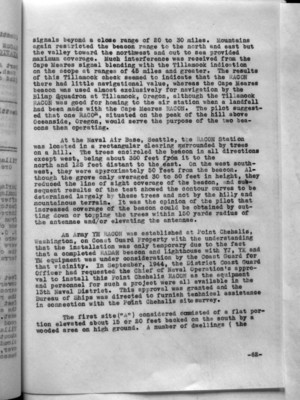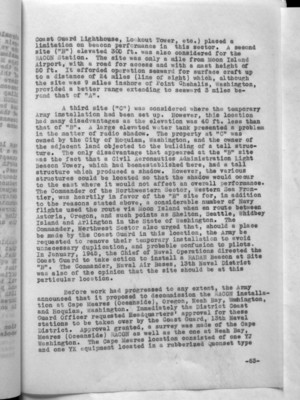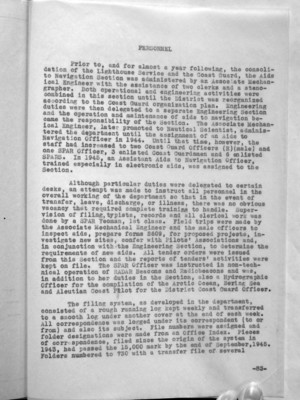Pages That Mention District Coast Guard Officer
Coast Guard District narrative histories 1945
74
the patrol boats for more appropriate duties. The buoy was a first class tall type nun, painted white and lettered "A".
The first four obstruction buoys to be established in the District were placed at the Entrance to Port Townsend, Washington, to mark the Navy Submarine net a year before the war. Shortly afterwards, the Navy also established a magnetic survey range at Port Townsend and requested the Coast Guard to provide and plant four ice spar buoys there; funds for the transaction were provided by the Navy. This particular type of buoy, the ice spar, was selected because of its availability in the District, its length and its ability to remain vertical during any stage of the tide. These buoys were authorized by Headquarters but were never installed here as the magnetic survey range was moved to Point Jefferson and they were placed on station in that area shortly after the outbreak of the war. All these buoys had a buoyancy chamber at the low water flotation mark to keep them upright in deep water and they were moored with a chain pendant. This type also marked the range positions with the least swinging radius as the water was too deep for a fixed structure. Additional flotation chambers were provided for the lighted buoys to keep the buoy floating perpendicularly. The fog signal, however, was necessarily installed on a fixed structure.
Two Port Townsend Obstruction Lights ("A" and "D") were established in 1941, together with two unlighted Obstruction Buoys ("B" and "C"). Headquarters, in August of that year, approved the installation of Marrowstone Obstruction Light 1 and Point Hudson Dolphin Obstruction Light 2 at the entrance of Port Townsend Bay in Washington. Two other lights were authorized by Headquarters but were not installed as the need for them had decreased. In addition to these special aids to navigation, the Port Townsend area provided an obstruction lighted bell buoy, obstruction light and a lighted bell buoy. The Point Jefferson Degaussing Range included lighted spar buoys (12 were originally established but 2 were discontinued) a mooring buoy, placed on station there for small guard vessels.
These special RADAR calibration buoys were war measures and, though activities in this field were continued after the war, they were gradually reduced. The Degaussing Range, however, continued in operation at full strength, the Navy having informed the District Coast Guard Officer that the range would be necessary for at least a year after cessation of hostilities. These special aids, then, remained to the Coast Guard to service and maintain; one more activity added to its peace time function.
-54-
77
space for and accept responsibility of the security, monitoring and maintenance of these installations. The local maintenance crew had no responsibility for repairing the equipment; this was the charge of the Radio Material Office.
By the end of May, 1943, RACONS were in operation at the above Coast Guard Units as well as at the Port Angeles Air Station and Tatoosh Island, Washington. The Army Signal Corps had installed a RACON at the Grays Harbor Fog Signal Station, Westport, Washington, which was operated and maintained entirely by Army personnel. The Coast Guard had no cognizance of this Army RACON other than its existence for the equipment and its operation was classified as "Secret" and carefully guarded. This RACON was discontinued and the maintenance crew was withdrawn about a year after its installation when a new RACON was established at Hoquiam, Washington, also under Army supervision.
The YH RACON installations were in operation only a few months when the Navy advised that all activities were to be equipped with the newer, improved model of RACON, the YJ.³ Two YJ RACONS were installed in the former locations of the YH and the latter models, together with their antennae, spares and instruction books were placed in storage. The installation of the new equipment was again done under the supervision of the Radio Material Officer, 13th Naval District. At the same time, the Chief Of Naval Operations directed that a site be selected, plans drawn and estimates made for a complete RACON Lighthouse (YJ, AN/CPN-3, and AN/CPN-6, in duplicate). Surveys for this site were made by Radio Material Officer's representative and a representative of the District Coast Guard Officer.
RACONS had not proved themselves "aids" to navigation by the beginning of 1944. Improper performance was prevalent and was due, in the main, to inefficient maintenance and to lack of appreciation of the importance such equipment bore to the safe passage of aircraft. At this time, a Chief of Naval Operations directive^4 transferred all Navy pulse equipment to the Coast Guard for operation and maintenance; the equipment was turned over to the custody of the Coast Guard, thus eliminating any financial transaction. The first RACON Station to be transferred was the installation at Tillamook Naval Air Station which was assumed by the Coast Guard on 1 May, 1945. An inventory of all equipment (together with condition in which it was received) was signed by the Commanding Officer of the Group, Hammond. Inventories were kept on file at the RACON Station, Group, District Coast Guard Office and Headquarters. Equipment was later signed for by the District Property Officer which left only the operational end of transfer to the Aids to Navigation Section.
-57-
82
signals beyond a close range of 20 to 30 miles. Mountains again restricted the beacon range to the north and east but the valley toward the northwest and out to sea provided maximum coverage. Much interference was received from the Cape Meares signal blending with the Tillamook indication on the scope at ranges of 45 miles and greater. The results of this Tillamook check seemed to indicate that the RACON there had little navigational value, whereas the Cape Meares beacon was used almost exclusively for navigation by the Blimp Squadron at Tillamook, Oregon, although the Tillamook RACON was good for homing to the air station when a landfall had been made with the Cape Meares RACON. The pilot suggested that one RACON, situated on the peak of the hill above Oceanside, Oregon, would serve the purpose of the two beacons then operating.
At the Naval Air Base, Seattle, the RACON Station was located in a rectangular clearing surrounded by trees on a hill. The trees encircled the beacon in all directions except west, being about 350 feet from it to the north and 125 feet distant to the east. On the west south-west, they were approximately 50 feet from the beacon. Although the grove only averaged 30 to 50 feet in height, they reduced the line of sight coverage of the beacon, and subsequently results of the test showed the contour curves to be determined largely by these trees and not by the hilly and mountainous terrain. It was the opinion of the pilot that increased coverage of the beacon could be obtained by cutting down or topping the trees within 150 yards radius of the antennae and/or elevating the antennae.
An Army YH RACON was established at Point Chehalis, Washington, on Coast Guard Property with the understanding that the installation was only temporary due to the fact that a completed RADAR beacon and Lighthouse with YJ, YK and YM equipment was under consideration by the Coast Guard for that vicinity. In September, 1944, the District Coast Guard Officer had requested the Chief of Naval Operation's approval to install this Point Chehalis RACON as the equipment and personnel for such a project were all available in the 13th Naval District. This approval was granted and the Bureau of Ships was directed to furnish technical assistance in connection with the Point Chehalis site survey.
The first site ("A") considered consisted of a flat portion elevated about 15 or 20 feet backed on the south by a wooded area on high ground. A number of dwellings ( the
-62-
83
Coast Guard Lighthouse, Lookout Tower, etc.) placed a limitation on beacon performance in this sector. A second site ("B") elevated 300 ft. was also considered for the RACON Station. The site was only a mile from Moon Island Airport, with a road for access and with a mast height of 50 ft. It afforded operation seaward for surface craft up to a distance of 24 miles (line of sight) which, although the site was 9 miles inshore of Point Chehalis, Washington, provided a better range extending to seaward 3 miles beyond that of "A".
A third site ("C") was considered where the temporary Army installation had been set up. However, this location had many disadvantages as the elevation was 40 ft. less than that of "B". A large elevated water tank presented a problem in the matter of radio shadow. The property at "C" was owned by the City of Hoquiam, Washington, and the owner of the adjacent land objected to the building of a tall structure. The only disadvantage that appeared at the "B" site was the fact that a Civil Aeronautics Administration Light Beacon Tower, which had been established there, had a tall structure which produced a shadow. However, the various structures could be located so that the shadow would occur to the east where it would not affect an overall performance. The Commander of the Northwestern Sector, Western Sea Frontier, was heartily in favor of the "B" site for, in addition to the reasons stated above, a considerable number of Navy flights used the route via Moon Island when en route between Astoria, Oregon, and such points as Shelton, Seattle, Whidbey Island and Arlington in the State of Washington. The Commander, Northwest Sector also urged that, should a place be made by the Coast Guard in this location, the Army be requested to remove their temporary installation to avoid unnecessary duplication, and probable confusion to pilots. In January, 1945, the Chief of Naval Operations directed the Coast Guard to take action to install a RADAR Beacon at Site "B". The Commander, Naval Air Bases, 13th Naval District was also of the opinion that the site should be at this particular location.
Before work had progressed to any extent, the Army announced that it proposed to decommission the RACON installation at Cape Meares (Oceanside), Oregon, Neah Bay, Washington, and Hoquiam, Washington. Immediately the District Coast Guard Officer requested Headquarters' approval for these stations to be taken over by the Coast Guard, 13th Naval District. Approval granted, a survey was made of the Cape Meares (Oceanside) RACON as well as the one at Neah Bay, Washington. The Cape Meares location consisted of one YJ and one YK equipment located in a rubberized Quonset type
-63-
103
Prior to, and for almost a year following, the consolidation of the Lighthouse Service and the Coast Guard, the Aids to Navigation Section was administered by an Associate Mechanical Engineer with the assistance of two clerks and a stenographer. Both operational and engineering activities were combined in this section until the District was reorganized according to the Coast Guard organizational plan. Engineering duties were then delegated to a separate Engineering Section and the operation and maintenance of aids to navigation became the responsibility of the Section. The Associate Mechanical Engineer, later promoted to Nautical Scientist, administered the department until the assignment of an Aids to Navigation Officer in 1944. Until that time, however, the staff had increased to two Coast Guard Officers (R) (male) and one SPAR Officer, 3 enlisted Coast Guardsmen and 6 enlisted SPARS. in 1945, An Assistant Aids to Navigation Officer, trained especially in electronic Aids, was assigned to the Section.
Although particular duties were delegated to certain desks, an attempt was made to instruct all personnel in the overall working of the department so that in the event of transfer, leave, discharge, or illness, there was no obvious vacancy that required complete training to handle. Supervision of filing, typists, records and all clerical work was done by a SPAR Yeoman, 1st class. Field trips were made by the Associate Mechanical Engineer and the male officers to inspect aids, prepare forms 2609, for proposed projects, investigate new sites, confer with Pilots' Associations and, in conjunction with the Engineering Section, to determine the requirements of new aids. All tender orders were issued from this Section and the reports of tenders' activities were kept on file. The SPAR Officer was instructed in non-technical operation of RADAR Beacons and Radiobeacons and was, in addition to her duties in the Section, also a Hydrographic Officer for the compilation of the Arctic Ocean, Bering Sea and Aleutian Coast Pilot for the District Coast Guard Officer.
The filing system, as developed in the department, consisted of a rough running log kept weekly and transferred to a smooth log under another cover at the end of each week. All correspondence was logged under its correspondent (to or from) and also its subject. File numbers were assigned and folder designations were made from an Office Index. Pieces of correspondence, filed since the origin of the system in 1943, had passed the 15,000 mark by the end of September, 1945. Folders numbered to 730 with a transfer file of several -83
